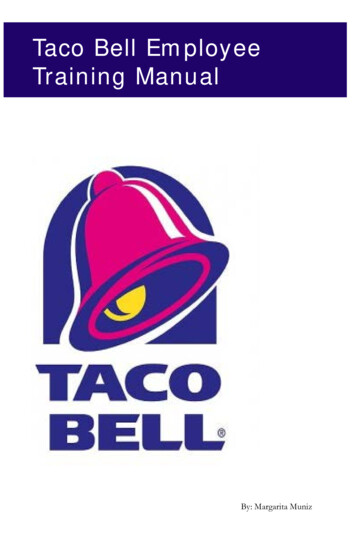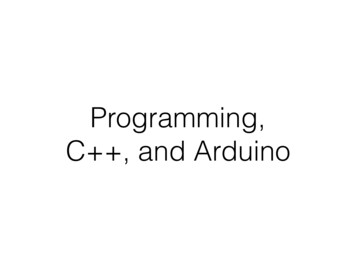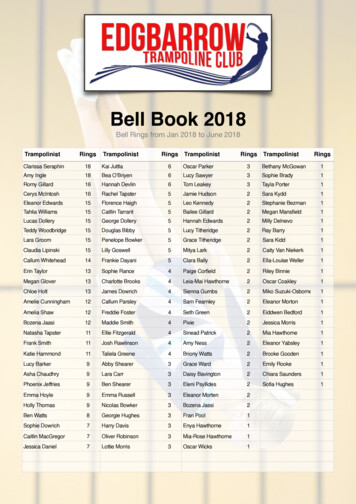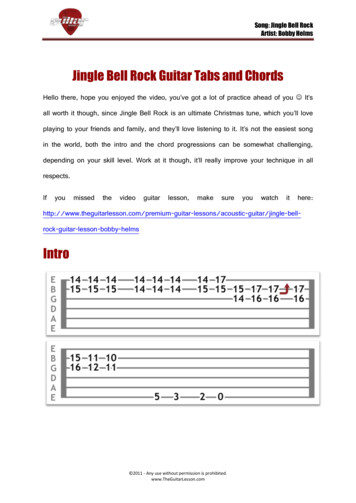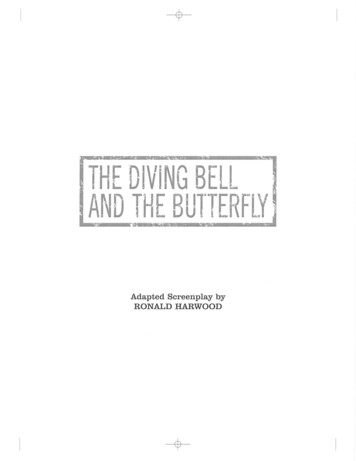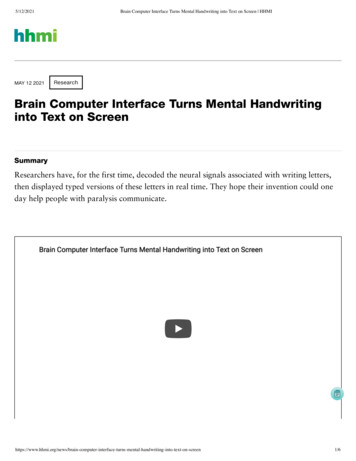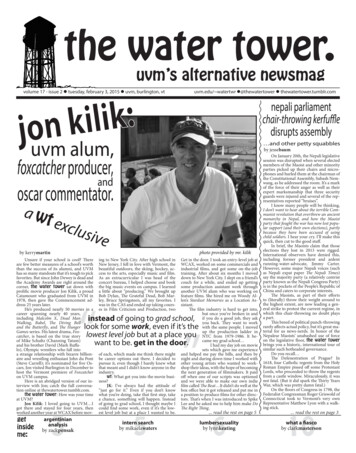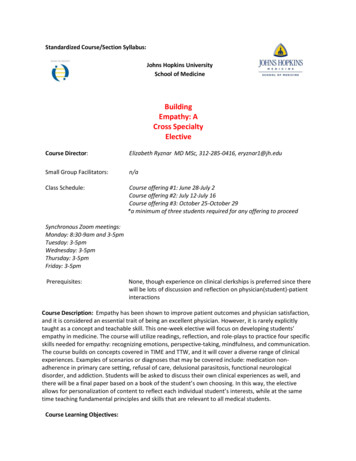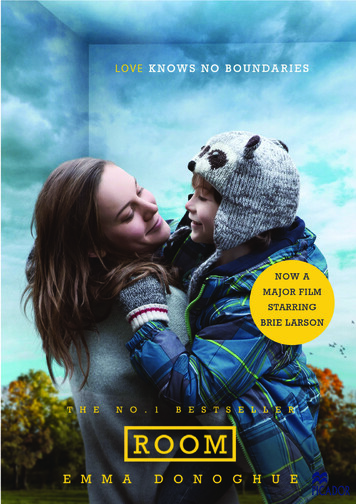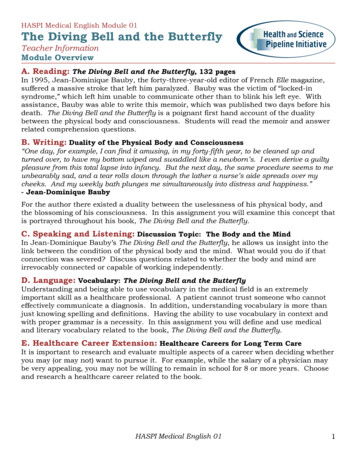
Transcription
HASPI Medical English Module 01The Diving Bell and the ButterflyTeacher InformationModule OverviewA. Reading: The Diving Bell and the Butterfly, 132 pagesIn 1995, Jean-Dominique Bauby, the forty-three-year-old editor of French Elle magazine,suffered a massive stroke that left him paralyzed. Bauby was the victim of “locked-insyndrome,” which left him unable to communicate other than to blink his left eye. Withassistance, Bauby was able to write this memoir, which was published two days before hisdeath. The Diving Bell and the Butterfly is a poignant first hand account of the dualitybetween the physical body and consciousness. Students will read the memoir and answerrelated comprehension questions.B. Writing: Duality of the Physical Body and Consciousness“One day, for example, I can find it amusing, in my forty-fifth year, to be cleaned up andturned over, to have my bottom wiped and swaddled like a newborn’s. I even derive a guiltypleasure from this total lapse into infancy. But the next day, the same procedure seems to meunbearably sad, and a tear rolls down through the lather a nurse’s aide spreads over mycheeks. And my weekly bath plunges me simultaneously into distress and happiness.”- Jean-Dominique BaubyFor the author there existed a duality between the uselessness of his physical body, andthe blossoming of his consciousness. In this assignment you will examine this concept thatis portrayed throughout his book, The Diving Bell and the Butterfly.C. Speaking and Listening: Discussion Topic: The Body and the MindIn Jean-Dominique Bauby’s The Diving Bell and the Butterfly, he allows us insight into thelink between the condition of the physical body and the mind. What would you do if thatconnection was severed? Discuss questions related to whether the body and mind areirrevocably connected or capable of working independently.D. Language: Vocabulary: The Diving Bell and the ButterflyUnderstanding and being able to use vocabulary in the medical field is an extremelyimportant skill as a healthcare professional. A patient cannot trust someone who cannoteffectively communicate a diagnosis. In addition, understanding vocabulary is more thanjust knowing spelling and definitions. Having the ability to use vocabulary in context andwith proper grammar is a necessity. In this assignment you will define and use medicaland literary vocabulary related to the book, The Diving Bell and the Butterfly.E. Healthcare Career Extension: Healthcare Careers for Long Term CareIt is important to research and evaluate multiple aspects of a career when deciding whetheryou may (or may not) want to pursue it. For example, while the salary of a physician maybe very appealing, you may not be willing to remain in school for 8 or more years. Chooseand research a healthcare career related to the book.HASPI Medical English 011
Common Core State Standards Addressed & Grade LevelAppropriate Grade Level: High School EnglishCommon Core State StandardsRL.1.11-12. Cite strong and thorough textual evidence to support analysis of whatthe text says explicitly as well as inferences drawn from the text, includingdetermining where the text leaves matters uncertain.RL.2.11-12. Determine two or more themes or central ideas of a text and analyzetheir development over the course of the text, including how they interact and buildon one another to produce a complex account; provide an objective summary of thetext.RI.1.11-12. Cite strong and thorough textual evidence to support analysis of whatthe text says explicitly as well as inferences drawn from the text, includingdetermining where the text leaves matters uncertain.RI.7.11-12. Integrate and evaluate multiple sources of information presented indifferent media or formats (e.g., visually, quantitatively) as well as in words in orderto address a question or solve a problem.W.1.11-12. Write informative/explanatory texts to examine and convey complexideas, concepts, and information clearly and accurately through the effectiveselection, organization, and analysis of content.W.7.11-12. Conduct short as well as more sustained research projects to answer aquestion (including a self-generated question) or solve a problem; narrow or broadenthe inquiry when appropriate; synthesize multiple sources on the subject,demonstrating understanding of the subject under investigation.SL.1.11-12. Initiate and participate effectively in a range of collaborative discussions(one-on- one, in groups, and teacher-led) with diverse partners on grades 11–12topics, texts, and issues, building on others’ ideas and expressing their own clearlyand persuasively.L.2.11-12. Demonstrate command of the conventions of standard Englishcapitalization, punctuation, and spelling when writing.L.3.11-12. Apply knowledge of language to understand how language functions indifferent contexts, to make effective choices for meaning or style, and to comprehendmore fully when reading or listening.L.4.11-12. Determine or clarify the meaning of unknown and multiple-meaningwords and phrases based on grades 11–12 reading and content, choosing flexiblyfrom a range of strategies.L.5.11-12. Demonstrate understanding of figurative language, word relationships,and nuances in word meanings.2HASPI Medical English 01
Time FrameActivityReading:The Diving Bell andthe ButterflyWriting:Duality – the Physical Body andConsciousnessSpeaking & Listening:Discussion Topic – The Bodyand the MindLanguage:Vocabulary – The Diving Belland the ButterflyHealthcare Career Extension:Long Term CareEstimated TimeActual Time (please note below)6 - 7 days(in-class or homework)3 - 5 days1 day6 - 7 days(concurrent with reading)1 - 2 daysAdditional InformationBook InformationThe Diving Bell and the Butterfly, A Memoir of Life in DeathAuthor: Jean-Dominique BaubyTranslated from French by Jeremy LeggartPublisher: 1997, Vintage International, A Division of Random House, Inc.ISBN: 0-375-70121-4Extension & ApplicationTo learn more about locked-in syndrome visit the National Rehabilitation InformationCenter (NARIC) at www.naric.com.A film based on The Diving Bell and the Butterfly was produced in 2007. It can bepurchased on Amazon for 10.00.ReferencesBauby, Jean. The Diving Bell and the Butterfly. Vintage International, Random House,1997. 132 pgs.Bigham, Jared T. The Common Core State Standards. www.corestandards.org.Centers for Disease Control and Prevention, U.S. Department of Health & HumanServices, www.cdc.gov.HASPI Medical English 013
Name(s):Period:Date:HASPI Medical English 01: ReadingThe Diving Bell and the ButterflyIntroductionIn 1995, Jean-Dominique Bauby, the forty-three-year-old editor of French Elle magazine,suffered a massive stroke that left him paralyzed. Bauby was the victim of “locked-insyndrome,” which left him unable to communicate other than to blink his left eye. Withassistance, Bauby was able to write this memoir, which was published two days before hisdeath. The Diving Bell and the Butterfly is a poignant first hand account of the dualitybetween the physical body and consciousness. In this assignment, you will read thememoir and answer related comprehension questions.Common Core State StandardsRL.1.11-12. Cite strong and thorough textual evidence to support analysis of whatthe text says explicitly as well as inferences drawn from the text, includingdetermining where the text leaves matters uncertain.RL.2.11-12. Determine two or more themes or central ideas of a text and analyzetheir development over the course of the text, including how they interact and buildon one another to produce a complex account; provide an objective summary of thetext.AssignmentPages 23 - 42Pages 1 - 22Read the following pages and answer the corresponding questions.1. What is a diving bell?2. How does the author compare his physical body to a diving bell? Why?3. What occurred to cause the author’s paralysis?4. Why do you think the author’s condition require collaboration from numeroushealthcare professionals for his care?5. Theorize why the introduction of the wheelchair was difficult for the author.6. What is locked-in syndrome?7. How does the author’s condition influence the behavior of his friends and familywho visit him? Speculate why.8. “Reflected in the glass I saw the head of a man who seemed to have emerged from avat of formaldehyde. His mouth was twisted, his nose damaged, his hair tousled, hisgaze full of fear. One eye was sewn shut; the other goggled like the doomed eye ofCain. For a moment I stared at the dilated pupil, before I realized it was only mine.”Put yourself in the author’s shoes. Describe your feelings of seeing yourself thisway.9. Who are the tourists in the chapter titled “Tourists”? Why did the author use thisdescription?10.How did other hospital patients view the author? Defend or argue against theirbehavior towards the author.11.How is the author fed? Imagine what it would be like to never taste food again.What would you miss most and why?12.The author claims his speech therapist is one of his most important hospital staffmembers. Do you agree or disagree with his opinion? Explain your answer.4HASPI Medical English 01
Pages 43 - 58Pages 59 - 88Pages 89 - 108Pages 109 - 13213.The author recalls some of his most poignant memories immediately before hisillness. Consider what you would remember clearly if you were in his position.14.Who is Noirtier de Villefort? Explain why this character became an importantcomparison for the author.15.Dreams become much clearer and easier to remember for the author. Theorize whythis has occurred for the author.16.Why was it necessary to sew the author’s eye shut?17.How did the care of the ophthalmologist impact his patient? Is the doctor’streatment of the author justified? Why or why not?18.The author speculates on possible titles for the play he may someday write abouthis experience. Provide a title for your life experience over the last month. Justifyyour title.19.In the chapter titled “Our Very Own Madonna” the author details a travelingexperience that does not necessarily integrate with the other book topics. Evaluatethe author’s decision to include this chapter and refute or support its inclusion.20.The author spends Father’s Day with his children. Speculate how the children’sinteractions with him are reflective of their age.21.Why was hangman an appropriate game for the author?22.What profession did the author have before his illness?23.Rumors circulated that Bauby was a vegetable. How did these rumors impact theauthor?24.Who helped the author write the book? Why were they necessary?25.The author found his work highly important before his illness. How does he reflectupon his time spent working after his illness?26.What did the racehorse “Mithra-Grandchamp” represent for the author?27.How did the author’s hearing disorder manifest?28.Explain why the author dreaded Sundays?29.Traveling created memories for the author that he was able to later reflect upon. Ifyou had the ability to travel anywhere to create lasting memories, where would it beand why?30.The author had different feelings about the hospital staff that cared for him. Whatprimarily motivated his feelings towards each staff member? Why is this importantto keep in mind when pursuing a career in healthcare?31.Summarize what the author was doing before his stroke.32.What of the author’s day-to-day activities do you believe the author would findimportant if he had known what would happen to him?33.What were the symptoms, if any, of his impending stroke?34.Summarize the book and it’s value to healthcare professionals who treat patients withsimilar syndromes that prevent communication between patients and staff.HASPI Medical English 015
Name(s):Period:Date:HASPI Medical English 01: WritingDuality: The Physical Body and ConsciousnessIntroduction“One day, for example, I can find it amusing, in my forty-fifth year, to be cleaned up andturned over, to have my bottom wiped and swaddled like a newborn’s. I even derive a guiltypleasure from this total lapse into infancy. But the next day, the same procedure seems to meunbearably sad, and a tear rolls down through the lather a nurse’s aide spreads over mycheeks. And my weekly bath plunges me simultaneously into distress and happiness.”- Jean-Dominique BaubyFor the author there existed a duality between the uselessness of his physical body and theblossoming of his consciousness. In this assignment you will examine this concept that isportrayed throughout his book, The Diving Bell and the Butterfly.Common Core State StandardsW.1.11-12. Write informative/explanatory texts to examine and convey complex ideas,concepts, and information clearly and accurately through the effective selection,organization, and analysis of content.b. Develop the topic thoroughly by selecting the most significant and relevant facts, extendeddefinitions, concrete details, quotations, or other information and examples appropriate to theaudience’s knowledge of the topic.c. Use appropriate and varied transitions and syntax to link the major sections of the text, createcohesion, and clarify the relationships among complex ideas and concepts.d. Use precise language, domain-specific vocabulary, and techniques such as metaphor, simile, andanalogy to manage the complexity of the topic.e. Establish and maintain a formal style and objective tone while attending to the norms andconventions of the discipline in which they are writing.f. Provide a concluding statement or section that follows from and supports the information orexplanation presented (e.g., articulating implications or the significance of the topic).AssignmentJean-Dominique Bauby experienced the loss of physical function, while his consciousnessblossomed. He states that, “.something like a giant invisible diving bell holds my wholebody prisoner,” while his “ mind takes flight like a butterfly.” Throughout his book heprovides examples of his failing physical body, and his ever-increasing awareness ofthoughts, emotions, and dreams. Write an essay summarizing the book. In your summaryinclude: A medical description of “locked-in syndrome”; what causes it, what are thesymptoms, how is it treated, etc. A comparison of the diving bell of his body, and the butterfly of his mind. Citespecific examples from the text. A personal reflection of how you might react in the same situation. Would and wheremight your mind go?6HASPI Medical English 01
Name(s):Period:Date:HASPI Medical English 01: Speaking and ListeningDiscussion Topic: The Body and the MindIntroductionIn Jean-Dominique Bauby’s The Diving Bell and the Butterfly, he allows us an insight intothe link between the condition of the physical body and the mind. What would you do ifthat connection were severed? How would it change your view of what is important in life?Does it change how you might react around individuals with similar disabilities? Discusswith members of a group questions related to the book, and whether the body and mind areirrevocably connected or capable of working independently.Common Core State StandardsSL.1.11-12. Initiate and participate effectively in a range of collaborative discussions (oneon- one, in groups, and teacher-led) with diverse partners on grades 11–12 topics, texts,and issues, building on others’ ideas and expressing their own clearly and persuasively.a. Come to discussions prepared, having read and researched material under study; explicitly draw onthat preparation by referring to evidence from texts and other research on the topic or issue tostimulate a thoughtful, well-reasoned exchange of ideas.AssignmentGet together in a group of 3-4 students. Discuss and answer the following questions basedon the book, The Diving Bell and the Butterfly, and your written assignment.Group Members:Question1. How does thetitle relate to thebook?Response2. What was theauthor’s purpose inwriting the book?HASPI Medical English 017
3. Varioushealthcareprofessionals wereresponsible for theauthors care. Doyou think it wasnecessary to haveso many specialistsinvolved? How doyou think thisimpacts the cost ofhis care?4. How does theauthor respond tohis condition?How did those(family, friends,hospital patients,staff, etc.) aroundhim impact hisresponse? Explainyour answer.5. Does the bookhave any impact onhow you viewpeople withdisabilities? Whyor why not?6. The author wasable to reflect onthe importance ofhis life due to hissudden illness.Support or refutethe claim that hisphysical paralysiswas a benefit to hisconsciousness.8HASPI Medical English 01
7. Assisted suicideis a hot issue. Doyou believesomeone in theauthor’s positionshould have thechoice to chooseassisted suicide?Defend youranswer.8. How would yourespond in thesame situation asthe author?9. Would yourecommend thisbook to others?Why or why not?HASPI Medical English 019
Name(s):Period:Date:HASPI Medical English 01: LanguageVocabulary: The Diving Bell and the ButterflyIntroductionUnderstanding and being able to usevocabulary in the medical field is anextremely important skill as ahealthcare professional. A patientcannot trust someone who cannoteffectively communicate a diagnosis.In addition, understandingvocabulary is more than just knowingspelling and definitions. Having theability to use vocabulary in contextand with proper grammar is anecessity. In this assignment you willdefine and use medical vocabularyrelated to the book, The Diving Belland the Butterfly.Common Core State StandardsL.2.11-12. Demonstrate command of the conventions of standard English capitalization,punctuation, and spelling when writing.a. Observe hyphenation conventions.b. Spell correctly.L.3.11-12. Apply knowledge of language to understand how language functions in differentcontexts, to make effective choices for meaning or style, and to comprehend more fullywhen reading or listening.a. Vary syntax for effect, consulting references (e.g., Tufte’s Artful Sentences) for guidance as needed;apply an understanding of syntax to the study of complex texts when reading.L.4.11-12. Determine or clarify the meaning of unknown and multiple-meaning words andphrases based on grades 11–12 reading and content, choosing flexibly from a range ofstrategies.a. Use context (e.g., the overall meaning of a sentence, paragraph, or text; a word’s position or functionin a sentence) as a clue to the meaning of a word or phrase.b. Identify and correctly use patterns of word changes that indicate different meanings or parts ofspeech (e.g., conceive, conception, conceivable). Apply knowledge of Greek, Latin, and Anglo-Saxonroots and affixes to draw inferences concerning the meaning of scientific and mathematicalterminology.c. Consult general and specialized reference materials (e.g., college-level dictionaries, rhymingdictionaries, bilingual dictionaries, glossaries, thesauruses), both print and digital, to find thepronunciation of a word or determine or clarify its precise meaning, its part of speech, its etymology,or its standard usage. CAd. Verify the preliminary determination of the meaning of a word or phrase (e.g., by checking theinferred meaning in context or in a dictionary).10HASPI Medical English 01
L.5.11-12. Demonstrate understanding of figurative language, word relationships, andnuances in word meanings.a. Interpret figures of speech (e.g., hyperbole, paradox) in context and analyze their role in the text.b. Analyze nuances in the meaning of words with similar denotations.AssignmentFor each set of vocabulary terms: Define each term Use the term in a sentence Choose 5 vocabulary terms and create a cohesive paragraphSet C: Pgs. 43-58Set B: Pgs. 23-42Set A: Pgs. 1-22Medical VocabularyCerebrovascular accidentResuscitationLocked-in syndromeTracheostomyDrip feedQuadriplegicGastric tubeRespiratorPalateRehabilitationDilatedMedical eaUrinary catheterLiterary ssedInaneHASPI Medical English 0111
Set D: Pgs. 59-88Set E: Pgs. 89-108Set F: Pgs. iaHASPI Medical English 01
Name(s):Period:Date:HASPI Medical English 01: Healthcare Career ExtensionHealthcare Careers for Long Term CareCommon Core State StandardsRI.1.11-12. Cite strong and thorough textual evidence to support analysis of whatthe text says explicitly as well as inferences drawn from the text, includingdetermining where the text leaves matters uncertain.RI.7.11-12. Integrate and evaluate multiple sources of information presented indifferent media or formats (e.g., visually, quantitatively) as well as in words in orderto address a question or solve a problem.W.7.11-12. Conduct short as well as more sustained research projects to answer aquestion (including a self-generated question) or solve a problem; narrow or broadenthe inquiry when appropriate; synthesize multiple sources on the subject,demonstrating understanding of the subject under investigation.ObjectivesAfter completing this assignment you will be able to:Evaluate multiple sources of information.Cite textual evidence for the healthcare career information.Conduct short research projects to educate yourself on career options, trainingopportunities, and education requirements within the healthcare field.AssignmentIt is important to research and evaluate multiple aspects of a career when deciding whetheryou may (or may not) want to pursue it. For example, while the salary of a physician maybe very appealing you may not be willing to remain in school for 8 or more years.1. Choose andcareers:CIRCLEone of the following healthcarePhysical TherapistNeurologistOccupational TherapistOccupational Therapist AideSpeech TherapistHASPI Medical English 0113
2. Research and answer the following questions. A minimum oftwo sources should be utilized. Record and cite your resources.QuestionAnswera. Summarize theresponsibilities ofthe healthcareprofession.b. In what type ofenvironment doesthis healthcareprofessional work?c. What is theaverage salary forthis profession?d. What is thecareer outlook (jobavailability) forthis profession?e. What educationand/or trainingare required?14HASPI Medical English 01
f. Find at least 3education ortraining programsnear you for thisprofession. Listthe location,requirements toattend theprogram, andprogram length.ProgramLocationRequirementsProgramLengthg. Choose one !program fromquestion “f” andsummarize theapplicationprocess for theprogram.h. If available,what would be thecost for thisprogram fromstart to finish?h. Cite yourresources.Extending the AssignmentCreate a brochure, newsletter, or poster to educate other about this career.HASPI Medical English 0115
The Diving Bell and the Butterfly Teacher Information Module Overview A. Reading: The Diving Bell and the Butterfly, 132 pages In 1995, Jean-Dominique Bauby, the forty-three-year-old editor of French Elle magazine, suffered a massive stroke that left him paralyzed. Bauby was the victim of “locked-inFile Size: 1MB
